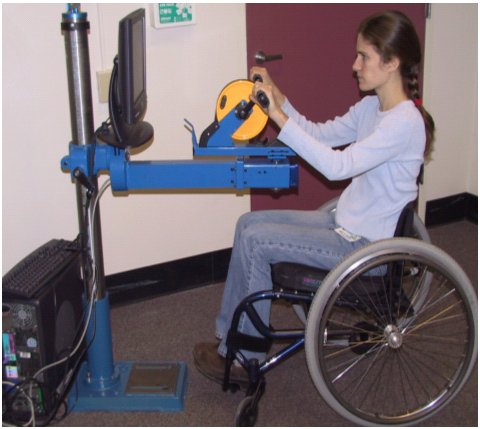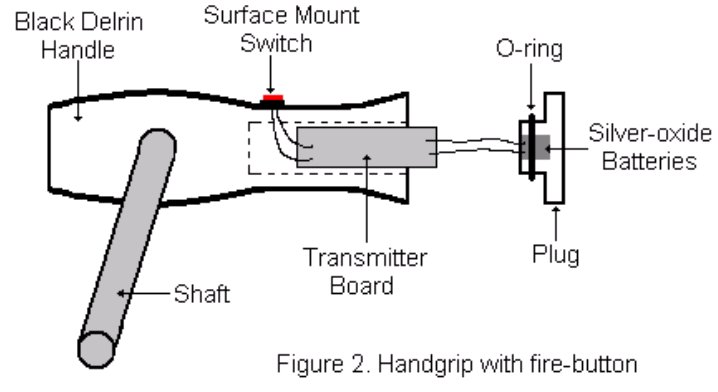ADDITION OF A WIRELESS "FIRE-BUTTON" TO THE USER INTERFACE OF THE GameCycle EXERCISE SYSTEM
ABSTRACT
Exercise is important to the physical health and well-being of all people and helps in the prevention of cardiovascular disease, high blood pressure, obesity, and diabetes. This is especially true for persons with disabilities, who tend to have lower activity levels in general. The GameCycle exercise system is an interface between an arm ergometer and a computer game and was designed to provide motivation to individuals who use wheelchairs to exercise on a regular basis. This paper discusses the design and testing of a wireless fire-button located within the ergometer handgrips. This will allow users to play a wider variety of video games with the GameCycle system and control more game functions without use of a keyboard or mouse.
BACKGROUND
 |
The GameCycle system is an interface between a standard arm ergometer and a computer game, allowing for game playing while exercising. As the user turns the arm ergometer, the speed of the game piece (e.g. car, player) moves proportionately to the rate of ergometer. In addition, the support frame of the ergometer can pivot left and right to determine the heading of the game piece. These motions simulate the motion of a computer joystick. The user is provided feedback though a computer monitor showing the video game. The addition of game play to exercise could improve the chances that the user will exercise more often and achieve or maintain their fitness level. Figure 1. User at GameCycle Results from an initial Phase I study of subjects using the GameCycle system showed that oxygen consumption and carbon dioxide production were significantly higher (p<0.005) when using the GameCycle system versus an arm ergometer without game play. Also, it was found that there were not significant differences in ratings of perceived exertion between conditions with or without game play. This would indicate that users expended more calories while using the GameCycle system with game play without an increase in perceived exertion.
STATEMENT OF THE PROBLEM
The original GameCycle system did not provide the user with the fire-buttons found on joysticks. This limited the variety of video games that could be played using the GameCycle and the game controlling functions accessible without a keyboard and mouse. For optimum user convenience, the fire-buttons should be integrated into the arm ergometer handgrip so that the user will not have to take their hand off the handgrip to press the button. This will allow for continuous cranking and exercise. The signal transmitter in the handgrip needs to be self-contained so that there is no need for external wires and two expensive slip rings to prevent wires from tangling while turning the arm ergometer. Radio frequency (RF) should be used for signal transmission because "line of sight" is not guaranteed for infrared transmission. The fire-button on the handgrip face should be impervious to moisture to prevent corrosion of the electrical components inside. The fire-button also needs to be positioned in a comfortable position that the user can reach while cranking the arm ergometer
RATIONALE
Some users from the Phase I study showed an interest in having "fire-control" buttons in order to allow them to use additional features of a wider variety of video games. Thus, buttons would let a person use more features of games they enjoy and add to the motivation of exercising with the GameCycle system. Additionally, the button permits the game operation and menu selection to be accomplished with less use of a keyboard and mouse.
DESIGN
The GameCycle control system emulates a game joystick. Standard gaming ports accommodate any two axes, four-button joystick. Therefore, it is possibile to add four fire-buttons to the GameCycle system.
DEVELOPMENT
 |
Because RF circuitry is expensive to develop from scratch, for proof of concept, a commercially available wireless door chime was purchased from RadioShack (CAT # 63-872A ). It consisted of two push button RF transmitters and one receiver that omits a chime when the transmitter button is depressed. The transmitter and receiver electronic boards were utilized in the GameCycle fire-button design. In order to fit the transmitter board inside the handgrip, an oblique angle handgrip was designed as a modified handcycle handgrip. The handgrip was turned from a black delrin round stock. On the top end, a 1" diameter 2" deep chamber was hollowed out. A delrin removable plug was fashioned to close off the chamber. A rubber O-ring was utilized to give the plug a snug fit and to keep moisture out of the chamber. Two silver-oxide batteries (Energizer 357 1.55V/155mAh) were fit into the inside portion of the plug. A momentary tactile switch was fitted into a 1/8" deep pocket on the handgrip surface and secured with an epoxy. The switch was positioned for easy access by the user's index finger. The transmitter electronic board was slid into the chamber prepared in the handgrip. Input wires were attached to the switch button mounted on the handgrip face. Power for the electronics was obtained from the two batteries fixed in the chamber plug. When the handgrip fire-button is depressed, information is sent via radio frequency (RF) to the receiver board. Thus, the fire-button requires no external wiring.
When the receiver board detects the transmitter's RF signal, the receiver normally produces a current through the speaker (chime). For the GameCycle, the speaker leads were connected to a reed relay (5V, 20mA). When energized, the relay grounds the fire-button pin number 2 of the 15 pin game port interface. The computer is then alerted that the fire-button has been pressed and an appropriate event then occurs in the video game being played.
EVALUATION/DISCUSSION
A working prototype has been fabricated and successfully operates with the GameCycle system. In a sample video game, Need for Speed II (Electronic Arts), items could be selected from game menus by pressing the fire-button. Navigation through the menu was accomplished by turning the arm ergometer crank. During game play, the fire-button was able to control one function of choice that is normally controlled by a keyboard key.
Continuation of work on the fire-buttons will include creating an identical handgrip/fire-button for the opposite side of the ergometer. With two fire-buttons, interference issues may need to be addressed. Other types of switches will be investigated to determine which is most functional and comfortable for the user. Also, custom transmitter and receiver circuit boards will be fabricated to replace the purchased boards.
Additional modifications to the GameCycle user interface will remove some limitations of the original design. A variety of handgrips will be made to accommodate users with impaired hand function. The arm crank length and width out to the handles will be made adjustable to fit various sized users of the GameCycle system. These changes would enhance the device functionality, universality, and the comfort and safety for the user.
-
U.S. Department of Health and Human Services. Healthy People 2010: Understanding and Improving Health. 2nd ed. Washington, DC: U.S. Government Printing Office, November 2000.
-
Janssen, T. W. J., Van Oers, C.A.J.M., van der Woude, L.H.V., & Holland, A.P. (1994). Physical strain in daily life of wheelchair users with spinal cord injuries. Med. Sci Sports & Ex, 26(6):661-670.
-
Sedlock, D.A., Knowlton, R.G., & Fitzgerald, P.I. (1990). Circulatory and metabolic responses of women to arm crank and wheelchair ergometry. Arch Phys Med & Rehab, 71:91-100.
-
Wenger NK, Froelicher ES, Smith LK, et al. Cardiac Rehabilitation. Clinical Practice Guideline No. 17. Rockville , MD. US Department of Health and Human Services, Public Health Service, Agency for Health Care Policy and Research and National Heart, Lung, and Blood Institiute. AHCPR Pub. No 96-0673. October 1995.
-
van der Woude L.H.V., Bakker W.H., Elkhuizen J.W., Veeger H.E.J., & Gwinn T. (1998) Propulsion technique and anaerobic work capacity in elite wheelchair athletes. Am J Phys Med Rehabil, 77:222-34.
ACKNOWLEDGMENTS
This study is partially funded by the NIH STTR Grant # 1R43HD42944-01, NIDRR Model System SCI (Grant # H133N000019)
Beth Ann Kaminski,
Human Engineering Research Laboratories,
VA Pittsburgh Healthcare System
7180 Highland Drive
Building 4, 2nd Floor, East Wing, 151R-1
Pittsburgh, PA 15206
412-365-4850
412-365-4858 (fax)
bak1@pitt.edu
